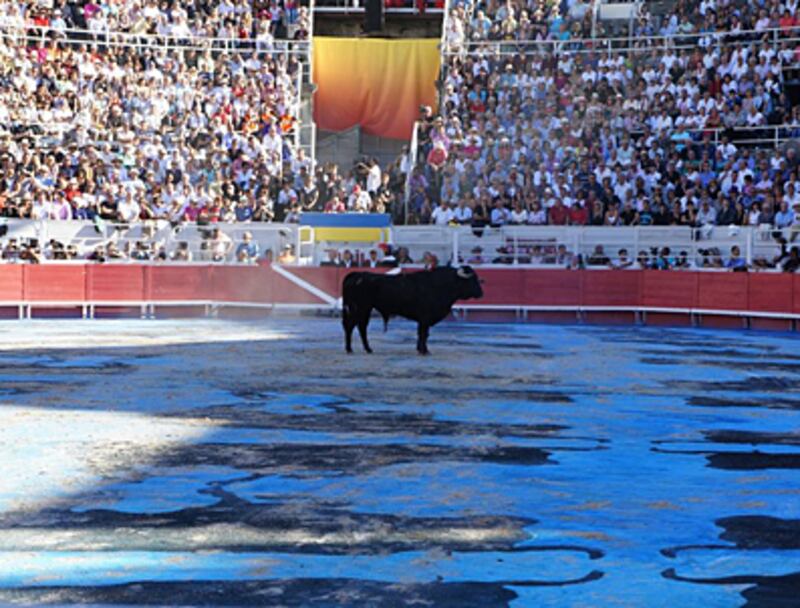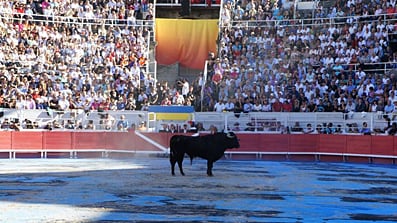“I’m in the middle of painting the Goyesque,” the artist Ena Swansea texted from the Roman amphitheater in Arles just a couple weeks ago. When we finally spoke hours later, there was such a background din that it wasn’t much of a call. “I’m in with all the matadors,” Swansea explained.
Perhaps I should backtrack here.
The corrida Goyesque, it turns out, involves an artist’s contribution to bullfighting season—usually in the form of a gigantic mural drawn on the arena’s floor—which is a Spanish and French tradition stemming from and paying homage to Francisco Goya himself, who was wild about bullfighting and painted it with gusto.
In Arles, said Swansea, “The matadors also dress in historical, Goya-era costumes, but way flashier. Goya reputedly was a matador himself when he was young, and indubitably was completely crazy about bullfighting and made the most unforgettable images associated with it.” September 10 was the eve of the closing of Arles’ bullfighting season.
Swansea, who is Manhattan-based, was alerted to the Goyesque idea when she saw pictures of Christian Lacroix’s Goyesque renderings two years ago. “I felt that I could make something that would perhaps add meaning to that world,” she told me, from a matador-free location. “So I started pitching it.”
Swansea approached the owner of the arena in Arles, got the gig, and set to work.
“I spent several months trying to have a decent idea,” said Swansea, who researched bullfighting for a full year before starting her own piece. “And I felt that all my ideas were mediocre. Then, it came to me in my sleep fully resolved.” What she saw was “a lattice-work of bulls.”
“It wasn’t exactly a dream,” Swansea said, but once she woke, she realized she would need the help of an architect. Swansea enlisted the Brooklyn-based architect Ben Krone, and together they created an image.

“The idea is 100 shadows of a charging bull. Then we sent it to an engineer in California. And to a guy in Atlanta who had a giant computer. He printed the image on very heavy plastic, to the scale of the arena. Then we FedExed that plastic drawing, which weighed 300 pounds, to France.”
Swansea was on a deadline of just under 18 hours to make the biggest painting in the world—a painting soon to be destroyed by seven bulls.
An artist in Arles cut the bull shapes from rolls of linoleum. “Each piece was numbered. It was really complicated. Like an enormous puzzle,” Swansea noted.
Swansea employed a team of 15 assistants (which she’d never used before), comprised of local artists and teachers, who set to work in the ancient arena at 11 p.m. on a Friday night, under floodlights and the September night sky. They were on a deadline of just under 18 hours to make the biggest painting in the world—a painting soon to be destroyed by seven bulls.
They painted the area of sand, roughly the size of a football field, with a radiant sky-blue pigment, and layered the linoleum bulls atop the azure.
“When the mayor got there he was shocked because the choir was singing, the orchestra was playing, and there were 20,000 people. And the painters were still working on the floor of the area. Painting the bulls,” Swansea remembered.
But they finished on deadline. There was a parade. The mayor brought out Swansea, who got an ovation. And the first bull charged out promptly at five p.m. (“Across a wet painting,” Swansea said.)
The bulls wasted no time in trampling the fine art. “It happened rather quickly. The first bullfight was a matador on horseback. In the Sunday newspaper, the reporter said that the painting stayed somehow alive through the whole bullfight. But it changed a great deal,” said Swansea.
In the end, all seven bulls were killed. “A unique event,” said Swansea, “Because it was the first time in that arena that 10 ears had been awarded to the matadors. That’s very unusual.”
To the victor go the spoils and in the case of matadors, they often keep an ear or two, and sometimes a tail, as a trophy of their fights.
What was the metaphorical bull’s ear for Swansea, a lifelong vegetarian? She was, in a word, “Tired." But, she added, “The bullfight is an ecosystem and, one could say, an honest one.”
Plus: Check out Art Beast, for galleries, interviews with artists, and photos from the hottest parties.
Anthony Haden-Guest is the news editor of Charles Saatchi’s online magazine.





